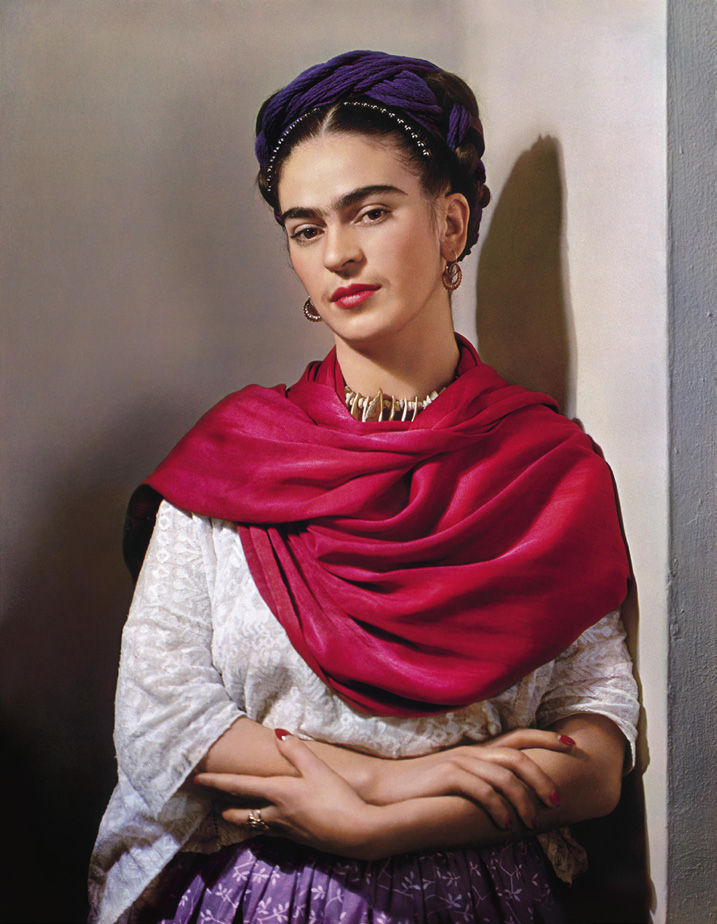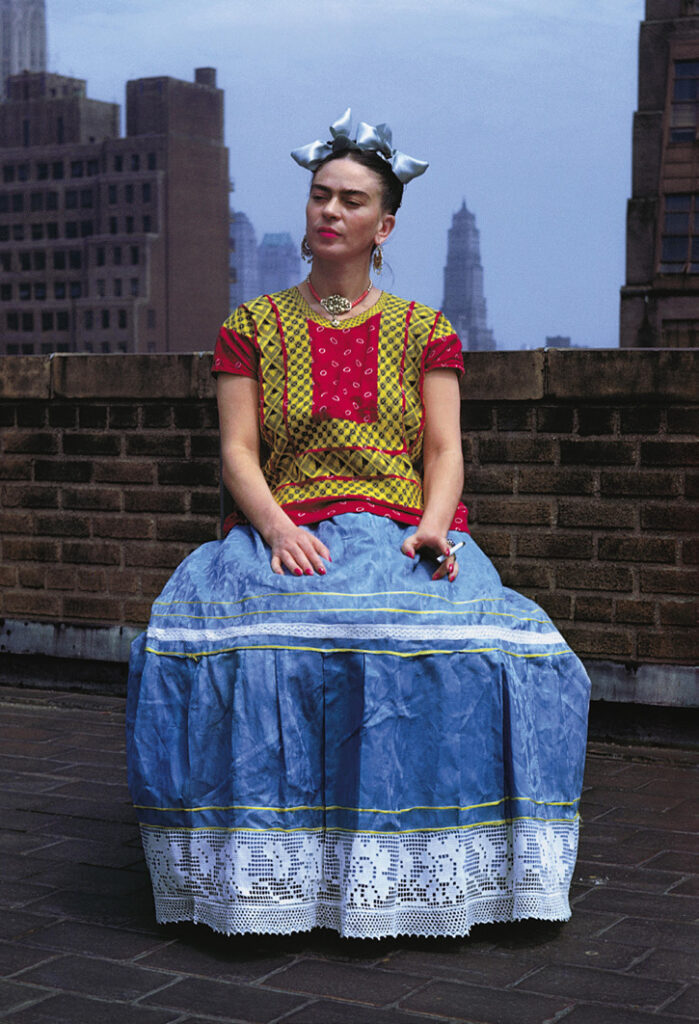
When Frida Kahlo returned to her Mexico City home in 1939 after an exhibition of her paintings in Paris, she found that photographer Nickolas Muray had sent her the portrait Frida in Magenta Rebozo. He took the photograph in his New York studio during one of Kahlo’s trips to the city. Her thank-you note in imperfect English expresses gratitude and deep affection:
“Nick darling, I got my wonderful picture you send to me, I find it even more beautiful than in New York…To me…it is a treasure…And now I have it near me. You will always be inside the magenta rebozo (on the left side).”
Kahlo leans against a wall and looks directly at the camera, hands relaxed and head tilted slightly. Her shadow is a soft blur on the gray wall and a more distinct outline on the right. Her figure emerges from this alcove in the saturated colors and rich textures that made Muray one of the most successful portrait photographers of the period. A sparkling headband and a violet fabric braid interwoven with her hair echo the oval of her face. Warm light casts an iridescent sheen on the magenta rebozo. Its gracefully-draped folds mirror the lines of her arms and fingers. Below the lustrous white tones of the blouse, we glimpse a floral purple skirt. Kahlo’s metalwork earrings and ring and natural-shell necklace are counterpoints, along with the rose lipstick and nail polish that she favored.

But it is Kahlo’s gaze—intimate and a little enigmatic—that rivets the viewer. Her expression hints at the amorous emotion of her thank-you letter. The portrait’s romantic mood reflects an intermittent ten-year love affair between Kahlo and Muray. In 1931, the photographer, 39 and just married to his third wife, traveled with his friend, the Mexican caricaturist and painter Miguel Covarrubias. They visited acclaimed muralist Diego Rivera and his wife, 34-year-old Frida Kahlo, at their home in the historic Coyoacán district of Mexico City. Kahlo was not yet well-known as a painter; Muray’s portraits of celebrities ranging from Greta Garbo to Claude Monet had been appearing in Harper’s Bazaar and Vanity Fair for a decade. The details of that first meeting are unknown. Over the next decade, their many rendezvous took place during Muray’s Mexican sojourns and Kahlo’s trips to the United States, initially when she accompanied Rivera on his commissions, and then as she became better known as an exhibiting artist.
Kahlo was Muray’s collaborator in the creation of over 90 photographs. She was an experienced subject: her father Guillermo Kahlo, a German immigrant to Mexico, was a documentary photographer of architecture and industrial sites. He also took many studio portraits of himself and of Frida. From observing his methods and assisting him on assignments, she learned how to communicate ideas—personal and political—with costume, props, poses, lighting, and composition. Muray’s photographs captured the elements of her character that she most wanted to represent.
The Mexican Revolution (1910–20), which ended a 30-year dictatorship in favor of a constitutional republic, generated pride in the nation’s pre-colonial cultures. In Frida with Olmeca Figurine, she holds a figure from the ancient Olmec civilization of the Gulf coast, celebrated for its stone sculpture. She wears a huipil, the tunic made from rectangular fabric strips and commonly worn by indigenous women throughout Mexico. Her jewelry honors Mexico’s silversmithing traditions, both indigenous and Spanish.

Frida on Rooftop foregrounds the traditional billowing “Tehuana skirt” worn in Mexico’s Isthmus of Tehuantepec, a community in Oaxaca, where women achieved a degree of economic and social independence by their control of local marketplaces. Kahlo’s mother was of Tehuana descent, and Kahlo appreciated the culture’s aesthetic sophistication. She viewed Tehuana society as the converse of modern Mexican expectations that women should be self-sacrificing and subservient.
The skirt epitomized her own mixed racial heritage. Kahlo was sensitive to such co-existing identities. She was bisexual, and commented that “I have the mustache and in general the face of the opposite sex,” which she never altered or concealed. The generous fabric also allowed her to hide the disfigurements of childhood polio and catastrophic injuries of a 1925 bus accident that caused her near-continuous pain throughout her life.
While Kahlo and Muray had other affairs during their relationship, they sustained their intense long-distance bond with both erotic passion and admiration for each other’s art. In 1939, Rivera and Kahlo divorced. By then it was clear to Muray—divorced since 1937—that her obsessive attachment to Rivera precluded any other permanent relationships, and Frida had become resentful of Muray’s other lovers. Their affair ended in 1940. Kahlo and Rivera re-married, and Muray married again in 1942. He wrote to Kahlo “caring for you will never end.” In the gritty rooftop setting of his 1946 image, Kahlo looks away, no less queenly than in the earlier photographs but with a certain world-weariness. She was in the city for spinal surgery, which, like many before it, did not relieve her pain. Kahlo and Muray remained friends until her death in 1954.

For several decades, Kahlo’s work has been widely exhibited, studied, and reproduced. Although Muray created the iconic visual imagery that largely defines Kahlo today, he remains less famous. He was born Miklós Mandl in 1892 in Szeged, Hungary, and raised in Budapest. He apprenticed in wood engraving and sculpture, and then studied photographic methods in Munich and Berlin, where he mastered the foundations of his trailblazing advances in color photography. In 1913, he arrived at Ellis Island near penniless and became Nickolas Muray. His experience gained him immediate work as a photoengraver while he took English classes at night. Within three years, he was a color technician for Vanity Fair. In 1920, alert to the current trend in celebrity “glamour portraits,” he opened his own studio in Greenwich Village. A winning personality and round-the-clock work won him a loyal following. A convivial and debonair figure, Muray often hosted evening soirées that attracted the cultural elite for conversation and, during Prohibition, sociable drinking. Writers, artists, actors, and dancers vied for his talent. Magazine portrait commissions took him to Hollywood, Washington, and Europe. Just a few of his subjects included James Joyce, Greta Garbo, President Calvin Coolidge, and Claude Monet. During the Depression, Muray’s technical advances revolutionized color advertising photography. In the 1940s, a new generation of movie stars sought him out, including Humphrey Bogart and Ingrid Bergman. Throughout his career, he consistently won prizes at international exhibitions.
In recent years, Muray’s photographs—which now reside in several museums—have drawn increasing academic and popular attention. His comment about his life’s work distills the empathetic philosophy that earned him enduring stature in the history of photography:
“Photography, fortunately, to me has not only been a profession but also a contact between people –to understand human nature and record, if possible, the best in each individual.” G&S
© 2021 Mary F. Holahan
Frida Kahlo: Through the Lens of Nickolas Muray On view at the Biggs Museum of America Art, Dover, Delaware November 5, 2021 – February 12, 2022 www.biggsmuseum.org
Exhibition catalogue: Salomon Grimberg, I Will Never Forget You / Frida Kahlo and Nickolas Muray / Unpublished Photographs and Letters. San Francisco (Chronicle Books, 2006)





Leave a Comment